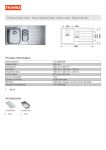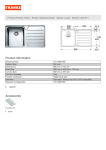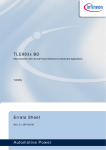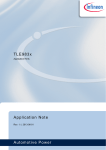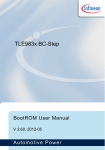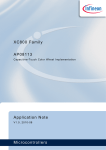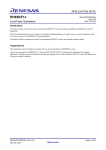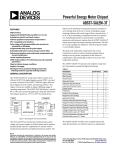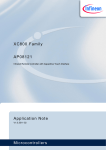Download Automotive Power Errata Sheet TLE983x BC
Transcript
TLE983x BC Microcontroller with LIN and Power Switches for Automotive Applications TLE983x Errata Sheet Rev. 1.4, 2013-02-26 Automotive Power Errata Sheet Rev. 1.4, 2013-02-26 TLE983x BC Microcontroller with LIN and Power Switches for Automotive Applications Overview This document lists the errata of these variants of the TLE983x BC device: TLE9831QV: TLE9831QV Data Sheet Rev. 1.1 TLE9832QV and TLE9832QX: TLE9832 Data Sheet Rev. 1.1 TLE9832-2QV: TLE9832-2 Data Sheet Rev. 1.1 1 Stop Mode Entry and Exit The Stop Mode needs to be entered and exited with a special configuration of the PLL. Otherwise the system can exit Stop Mode only with Reset. Workaround: Before entering Stop Mode the following flag needs to be set just before the execution of the Stop Mode command SFR_PAGE(_su6, noSST); OSC_CON |= 0x02; // switch to page6 // set intosc_force to '1' // (switch async to internal PLL clock) _nop_(); _nop_(); _nop_(); //needed for wakeup Directly after exiting Stop Mode the setting has to be cleared by using the following commands: Revision History: 1.4, 2013-02-26 Previous Version: 1.3, 2012-07-27 Major Changes: chapter 4 and 5.4 added Errata Sheet 1/4 Rev. 1.4, 2013-02-26 TLE983x BC SFR_PAGE(_su6, noSST); OSC_CON &= ~0x02; // // // // switch to page6 set intosc_force to '0' (PLL internal oscillator OSC_PLL is selected synchronously) Please note: Register OSC_CON is password protected. Before it can be modified it needs to be unlocked. Planned fix: description will be updated in the User Manual. No fix in silicon planned. 2 Low Side Switch turn on sequence During the Low Side Switches are disabled the ADC2 channels CH6 and CH7, that are responsible for the current measurement of the Low Side Switches, might sample undefined voltages. This can lead to the Low Side Switch Over Current flag LSx_OC_STS to be set. As defined the Low Side Switch Driver can only be activated with LSx_OC_STS = 0. Therefore it should be ensured that the Over Current flag LSx_OC_STS is cleared and the Low Side Switches are enabled (LSx_EN =1) before turning on the Low Side Switches (LSx_ON = 1). Workaround: Use this sequence to turn on the Low Side Switches: 1) write 0x01 into the Low Side Switch control register LSx_CTRL (LSx_EN). Bits 6 and 7 (LSx_OT_STS and LSx_OC_STS) are cleared in this write operation. 2) wait for at least 20 µs 3) write 0x05 into the Low Side Switch control register LSx_CTRL (LSx_EN, LSx_ON). Planned fix: next design step (BD) 3 Temperature coefficients The temperature coefficients in the corresponding data sheets are not valid. The valid coefficients are: Output voltage VTemp at T0=273 K (0°C) 0.4955 V (was 0.5365 V before) P_5.8.23 Temperature sensitivity b 1.807 mV/K (was 1.834 mV/K before) P_5.8.25 Workaround: use the valid coefficients in software to calculate the junction temperature. Errata Sheet 2/4 Rev. 1.4, 2013-02-26 TLE983x BC 4 Edge Detection on GPIOs requires rise time < 15µs The edge detection on GPIO (P0.x, P1.x, P2.x) input signals requires a rise time of < 15μs (20%-80% of 5V). Errata description (functional limitation) for rise times > 15μs: A rising edge is always signalled correctly as rising edge, but occasionally signalled as falling edge as well. The opposite case works as expected: A falling edge is always signalled correctly as falling, and never signalled as rising edge. The wrongly detected falling edges have influence on following functionality: Interrupt generation Edge counter Timer start based on detected edge All functional blocks that evaluate falling edges on GPIO input signals are affected, e.g. CCU6 in capture mode Timer external interrupts (EXTINT) UART Workaround: First recommendation: ensure an input signal rise time of < 15μs. If this is not possible, 3 cases need to be distinguished: In case only rising edges are evaluated, no workaround is required. In case only falling edges are evaluated, the errata described above occurs. No workaround is available for this case. In case both edges are used for interrupt generation, but depending on the edge different actions should be taken (e.g. in CCU6), following workaround can be used: Table 1 rising edge signalled falling edge signalled action no no no action no yes handle as falling yes no handle as rising yes yes handle as rising 5 Application hints 5.1 LIN overcurrent shutdown In the design step BC, both a LIN current limitation and a LIN overcurrent shutdown are implemented. Both events are signalled as interrupt LIN_OC_STS (if enabled), in addition an overcurrent shutdown disables the LIN transceiver. In that case, the LIN transceiver needs to be switched on again by software. Errata Sheet 3/4 Rev. 1.4, 2013-02-26 TLE983x BC 5.2 LIN Transceiver enabling with slow ramping With the default setting of register PCU_CTRL_STS_2, the LIN Transceiver is disabled whenever VS under voltage condition is met (VS <= 5.5V). It has to be ensured by software sequence, that only after leaving the VS under voltage condition (VS > 5.5V), which can be checked by software, the LIN module will be properly enabled. Implementation proposal: 1) check bit SYS_SUPPLY_STS. VS_UV_STS to be 0 2) then write 0x00 to register LIN_CTRL_STS_1 3) then write 0x06 to register LIN_CTRL_STS_1 (LIN normal mode) 5.3 Temperature calculation The formula to be used to calculate the junction temperature from the ADC output value is: Tj [°C] = ((ADC_out/256*1.23/1.24)-0.4955)*1000/1.807 with 1.23 Ref-Voltage ADC2 [V] 1.24 gain at differential input of ADC 0.4955 and 1.807 Temperature coefficients, see chapter “Temperature coefficients” 5.4 VDDEXT does not automatically switch off in case of short circuit In case of short circuit, the short circuit condition is signalled in VDDEXT_CTRL.VDDEXT_SHORT, but the VDDEXT is not switched off automatically. Switching off needs to be done explicitly in customer software (VDDEXT_CTRL.VDDEXT_ ENABLE = 0). Errata Sheet 4/4 Rev. 1.4, 2013-02-26 Edition 2013-02-26 Published by Infineon Technologies AG 81726 Munich, Germany © 2013-02-26 Infineon Technologies AG All Rights Reserved. Legal Disclaimer The information given in this document shall in no event be regarded as a guarantee of conditions or characteristics. With respect to any examples or hints given herein, any typical values stated herein and/or any information regarding the application of the device, Infineon Technologies hereby disclaims any and all warranties and liabilities of any kind, including without limitation, warranties of non-infringement of intellectual property rights of any third party. Information For further information on technology, delivery terms and conditions and prices, please contact the nearest Infineon Technologies Office (www.infineon.com). Warnings Due to technical requirements, components may contain dangerous substances. For information on the types in question, please contact the nearest Infineon Technologies Office. Infineon Technologies components may be used in life-support devices or systems only with the express written approval of Infineon Technologies, if a failure of such components can reasonably be expected to cause the failure of that life-support device or system or to affect the safety or effectiveness of that device or system. Life support devices or systems are intended to be implanted in the human body or to support and/or maintain and sustain and/or protect human life. If they fail, it is reasonable to assume that the health of the user or other persons may be endangered.






